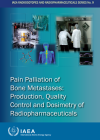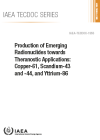Radiopharmaceuticals are radioisotopes bound to biological molecules able to target specific organs, tissues or cells within the human body. These radioactive drugs can be used for the diagnosis and, increasingly, for the therapy of diseases.
Diagnostic radiopharmaceuticals
The number of radiopharmaceuticals in clinical use is rapidly growing, thus allowing the medical community better access to detail information on the characteristics of the different types of tumours.
A radiopharmaceutical can be seen as an entity made up of a radionuclide and a vehicle molecule with high affinity – or binding power – for a tissue or a specific function of a human organ. It may also comprise only the radioisotope itself if it shows suitable biological properties.
Radiopharmaceuticals are used to produce images of organs or tissues of interest, a process that is called scintigraphy. A type of medical device known as gamma camera is able to detect the gamma rays emitted by the radioisotope. It generates in a non-invasive manner images that reflect the function of the organ or tissue under investigation.
The most widely used radioisotope in diagnostic nuclear medicine is technetium-99m. It can be attached to several specific molecules, allowing the diagnosis of many diseases, including certain types of cancers. For instance, technetium-99m-MDP (methylene diphosphonate) is widely used to detect bone metastasis associated with cancer.








